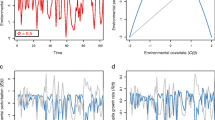Abstract
Estimates of a population’s growth rate and process variance from time-series data are often used to calculate risk metrics such as the probability of quasi-extinction, but temporal correlations in the data from sampling error, intrinsic population factors, or environmental conditions can bias process variance estimators and detrimentally affect risk predictions. It has been claimed (McNamara and Harding, Ecol Lett 7:16–20, 2004) that estimates of the long-term variance that incorporate observed temporal correlations in population growth are unaffected by sampling error; however, no estimation procedures were proposed for time-series data. We develop a suite of such long-term variance estimators, and use simulated data with temporally autocorrelated population growth and sampling error to evaluate their performance. In some cases, we get nearly unbiased long-term variance estimates despite ignoring sampling error, but the utility of these estimators is questionable because of large estimation uncertainty and difficulties in estimating correlation structure in practice. Process variance estimators that ignored temporal correlations generally gave more precise estimates of the variability in population growth and of the probability of quasi-extinction. We also found that the estimation of probability of quasi-extinction was greatly improved when quasi-extinction thresholds were set relatively close to population levels. Because of precision concerns, we recommend using simple models for risk estimates despite potential biases, and limiting inference to quantifying relative risk; e.g., changes in risk over time for a single population or comparative risk among populations.
Similar content being viewed by others
References
Allendorf FW, Bayles D, Bottom DL, Currens KP, Frissell CA, Hankin D, Lichatowich JA, Nehlsen W, Trotter PC, Williams TH (1997) Prioritizing pacific salmon stocks for conservation. Conserv Biol 11: 140–152
David HA (1985) Bias of s2 under dependence. Am Stat 39: 201
Dennis B, Munholland PL, Scott JM (1991) Estimation of growth and extinction parameters for endangered species. Ecol Monogr 61: 115–143
Dennis B, Ponciano JM, Lele SR, Taper ML, Staples DF (2006) Estimating density dependence, process noise, and observation error. Ecol Monogr 76: 323–341
Ferrari M, Taper ML (2008) Using auxiliary data on measurement error to improve estimates of process variation in ecological time series. Environ Ecol Stat (in press)
Fieberg J, Ellner SP (2000) When is it meaningful to estimate an extinction probability?. Ecology 81: 2040–2047
Graybill FA (1983) Matrices with applications in statistics. Wadsworth International Group, Belmont, CA
Holmes EE (2001) Estimating risks in declining populations with poor data. Proc Natl Acad Sci USA 98: 5072–5077
Holmes EE, Fagan WE (2002) Validating population viability analysis for corrupted data sets. Ecology 83: 2379–2386
Lande R, Orzack SH (1988) Extinction dynamics of age-structured populations in a fluctuating environment. Proc Natl Acad Sci USA 85: 7418–7421
Lindley ST (2003) Estimation of population growth and extinction parameters from noisy data. Ecol Appl 13: 806–813
Littell RC, Milliken GA, Stroup WW, Wolfinger RD (1996) Sas system for mixed models. SAS Institute, Cary, NC
Ludwig D (1999) Is it meaningful to estimate a probability of extinction?. Ecology 80: 298–310
Ludwig D, Walters CJ (1985) Are age-structured models appropriate for catch-effort data. Can J Fish Aquat Sci 42: 1066–1072
Ludwig D, Walters CJ (1989) A robust method for parameter-estimation from catch and effort data. Can J Fish Aquat Sci 46: 137–144
McNamara JM, Harding KC (2004) Measurement error and estimates of population extinction risk. Ecol Lett 7: 16–20
Meir E, Fagan WF (2000) Will observation error and biases ruin the use of simple extinction models?. Conserv Biol 14: 148–154
Morales JM (1999) Viability in a pink environment: why “White noise” models can be dangerous. Ecol Lett 2: 228–232
Morris WF, Doak DF (2002) Quantitative conservation biology: theory and practice of population viability analysis. Sinauer, Sunderland
Ripa J, Lundberg P (1996) Noise colour and the risk of population extinctions. Proc Roy Soc Lond Ser B 263: 1751–1753
Staples DF, Taper ML, Dennis B (2004) Estimating population trend and process variation for PVA in the presence of sampling error. Ecology 85: 923–929
Staples DF, Taper ML, Shepard BB (2005) Risk-based viable population monitoring. Conserv Biol 19: 1908–1916
Taper ML, Ponciano JM, Shepard BB, Muhlfeld CC, Staples DF (2008a) Risk based viable population monitoring of the upper flathead bull trout. Conserv Biol (in Press)
Taper ML, Staples DF, Shepard BB (2008b) Model structure adequacy analysis: selecting models on the basis of their ability to answer scientific questions. Synthese (in Press)
Author information
Authors and Affiliations
Corresponding author
Rights and permissions
About this article
Cite this article
Staples, D.F., Taper, M.L., Dennis, B. et al. Effects of sampling error and temporal correlations in population growth on process variance estimators. Environ Ecol Stat 16, 547–560 (2009). https://doi.org/10.1007/s10651-008-0097-5
Received:
Revised:
Accepted:
Published:
Issue Date:
DOI: https://doi.org/10.1007/s10651-008-0097-5




